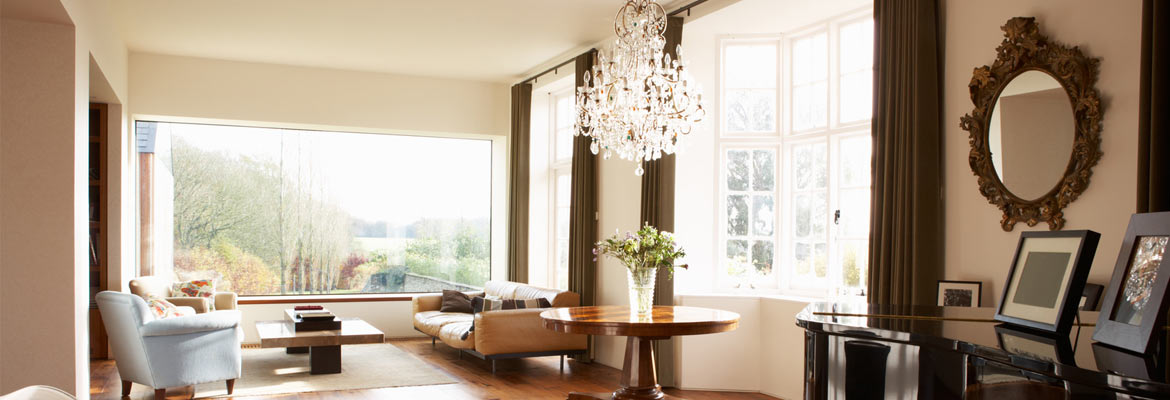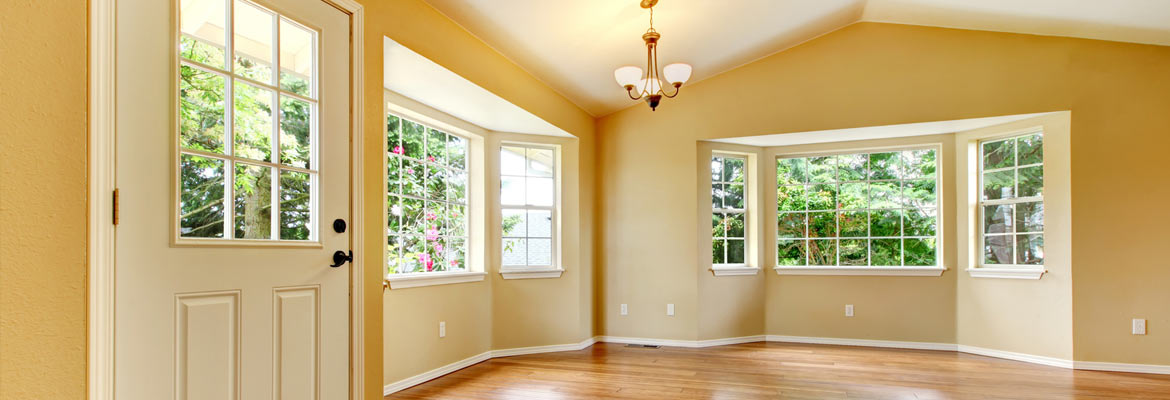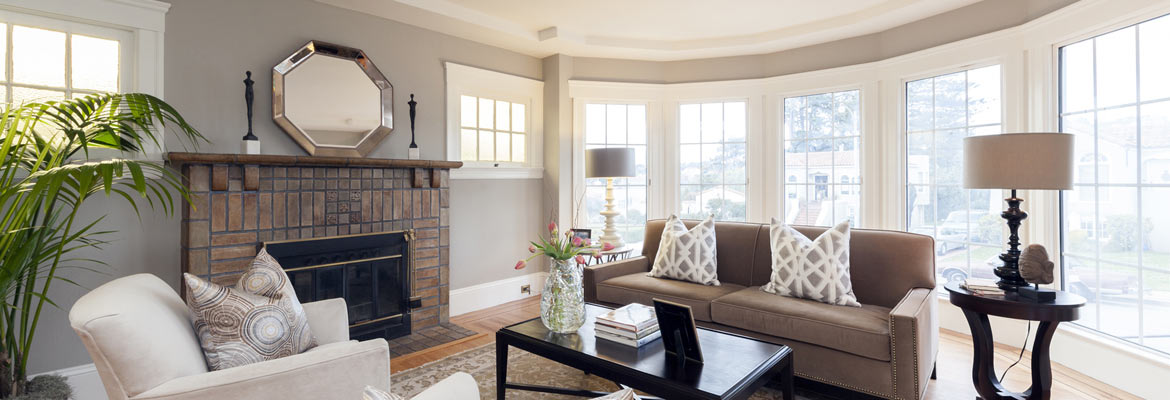If you’re interested in enhancing the aesthetics and curb appeal of your home, one upgrade that can make a significant impact is new windows. While standard windows can look great, if you want to create that wow factor, you should consider bay and bow windows. These are elegant window styles that provide an abundance of natural light and greater space, adding some flair to the exterior and interior of your home. But which one is best? Here we’ll explore bay vs bow windows to help you make an informed decision.
What Are Bay Windows?
The bay window is a classic choice that has been an architectural feature in homes since the 17th century. The typical configuration of a bay window is to have three vinyl windows that are arranged at angles to create a frame that extends outwards from the exterior wall of the house, creating extra space inside. Generally, the center window is larger and fixed, but the two smaller windows on either side are usually open.
Bay windows feature a large picture window in the center that tends to offer an unobstructed view. The windows on either side are often double-hung or casement windows that can be opened to provide ventilation. The typical configuration involves 30-degree or 45-degree angles, but it may be possible to have custom angles if necessary.
The Types of Bay Window:
Although the basic three panel structure of bay windows remains the same, there are several styles of bay window that may be better suited to the architectural style of your home.
| Type | Description |
| Box Bay | This configuration has a rectangular shape that is popular in modern homes. |
| Fully Bay | As the name suggests, full bay windows extend floor to ceiling, which provides an abundance of natural light and creates a dramatic effect. |
| Oriel Bay | When making a window styles comparison, the oriel bay stands apart as the window does not extend to the ground. It is supported by corbels or brackets and does not provide additional floor space inside. |
| Circle Bay | Circle bay windows have a rounded look that was made popular in Victorian homes. |
What Are Bow Windows?
Bow windows or as they are sometimes called, compass windows are distinctly different to bay windows. The window panels curve in a gentle arc to create a graceful and dramatic aesthetic. Unlike a bay window, typically the window panels are of an equal size. Homeowners can choose the combination of operable and fixed windows to suit their preferences.
Four-lite bow windows are the most compact configuration, while five-lite tends to be the most popular choice. However, if you are looking for a dramatic curve effect, a six lite bow window is the best option.

Detailed Comparison: Bay vs Bow Windows
According to architectural experts, “choosing between bay vs bow windows will depend on the style of your home and the view you would like to frame.” To help you appreciate the bow window vs bay window debate, we’ll lay out a comparison:
| Feature | Bay Window | Bow Window |
| Shape | Angular | Curved |
| Number of Panels | Generally 3 | Four or more |
| Projection Style | Pronounced | Subtle |
| Impact on Interior Space | Adds usable space | Creates a curved area |
| Light Distribution | Focused | Even |
| Typical Architectural Style | Modern & Traditional | Victorian & Contemporary |
| Aesthetic Appearance | The angular projection creates a panoramic view due to the large central picture window. | The semicircular projection creates a softer gentle arc which can project an elegant aesthetic. |
| Practical Consideration for Installation | Requires a strong support system and may require adjustments to the roof structure | Typically requires more horizontal space and additional structural support across the entire span. |
Pros and Cons of Bay Windows
| Pros of Bay Windows | Cons of Bay Windows |
|
|
|
|
|
|
|
|
|
Bay windows offer numerous advantages, with extra light and space that could transform your home. However, you will need to consider your home’s specific layout and your requirements.
Pros and Cons of Bow Windows
| Pros of Bow Windows | Cons of Bow Windows |
|
|
|
|
|
|
|
|
|
|
A bow window can create a dramatic visual impact, but you will need to consider the space requirements and your home’s style before committing to an installation.
Aesthetic and Functional Differences
When choosing home windows the bay and bow window differences that are most important to you are likely to relate to the aesthetics and functionality of the design. If you’re considering either type of window and are struggling with the bow window vs bay window debate, you will need to think about how either type would fit into your home.
Bay windows typically provide larger floor space. This can create more room that is ideal for seating or placing a table where you can sit and enjoy the panoramic views. The larger central window allows you to make the most of your view, while the side windows are highly practical since you can open them for ventilation.
Bow windows have a softer aesthetic that is reminiscent of Victorian homes which can be a great feature for modern homes. While this does not offer more floor space it can add symmetry to your room, particularly if you have a wide wall. You can also have more flexibility for a custom window installation, which will allow you to have windows that open according to your preferences.

Energy Efficiency Considerations
If you want a greener home, energy-efficient windows are a key feature. While both bay and bow windows do have more seams and joints compared to standard windows, the potential for heat loss is reduced with a proper installation.
It is important to choose windows made with high quality materials to ensure energy efficiency. There are also double and triple glass panels that are suitable for either style that can reduce heat loss and minimize noise pollution, which can be ideal if you live near a busy road.
You can also minimize the levels of ultraviolet and infrared light coming through the glass with Low E coatings. This does not impact the amount of natural light entering the home, but this transparent, microscopically thin coating reflects heat.
Installation and Cost Differences
The specific bay vs bow window cost for your home will vary according to the size and complexity of the installation. Both types of windows require proper support and will often necessitate modifying the existing window opening.
Although bay windows may require making adjustments to the roof structure to accommodate the window design, generally, bow windows are more costly. This is due to the more complex structure of bow windows and the need for additional window panels. Typically, bay windows have three panels, but the most popular bow window configuration is five panels.
There are numerous factors that impact window prices, but the degree of customization will have the most significant effect on the overall cost. For example, if you choose to have more operable windows, the cost of the installation will be higher than if you had more fixed windows.
Another important consideration for the bay vs bow window cost is the angle of the windows. One of the key bay and bow window differences is that bay windows typically have only three panels, which means that the angle of the panels is fixed at either 30 degrees or 45 degrees. On the other hand, you can choose how many window panels you would like in a bay window. While having more panels can create a more intricate design, it does increase the complexity and cost of the installation.
If you are considering custom windows in either style, it is a good idea to discuss your ideas and preferences with an experienced professional who can guide you through the process and costs.
Maintenance and Care Tips
Regardless of the bow window vs bay window debate, these window styles do require a little more care compared to standard windows. Since you have more window panels with both bay and bow windows, the cleaning and maintenance can be a little more involved.
You should clean your windows at least a couple of times per year, but it will need to be more frequent if you live near the ocean or in a high-pollution area. You will need to use appropriate cleaning solutions for the type of frame. Be sure to inspect the frame for any signs of damage or wear, particularly if you’ve opted for wood frames.
Since bay and bow windows have more panels, you will need to regularly check the seals and weather stripping along the panels and edges of the window. You will need to replace any worn or damaged seals to prevent energy loss, drafts or water leaks.
Finally, don’t forget that your bay or bow window may have a roof. You will need to check the roof regularly for signs of leaks or pooling water. Some window styles will have a rainwater outlet to prevent pooling, but you will need to regularly clean the outlet, removing dirt, leaves or other debris that may impede the water flow.
Checklist for Bay and Bow Window Care and Maintenance:
- Clean the glass: Clean the glass panels two or three times a year
- Inspect the frames for signs of wear or damage
- Inspect the weather stripping and seals
- Lubricate the hardware, including locks, handles and hinges
- Repaint or re-stain the frames if you’ve opted for wooden frames
- Inspect the bay or bow window roof for water pooling
Conclusion: Making the Right Choice
When you’re assessing bay vs bow windows to choose the right one for your home, you will need to think about the style of your home and your specific space. Bay windows are better suited to traditional homes, while bow windows look attractive with contemporary or Victorian style homes.
Both styles provide plenty of light, but a bay window may offer more ventilation. It is possible to have more operable window panels with a bow window design, but this customization is likely to increase the overall cost.
FAQs:
- Can you replace flat windows with bay or bow windows?
In most cases, it is possible, but you will need to assess the specific requirements of your property. You may need to make structural modifications, so careful planning is crucial.
- Do bow and bay windows affect the home’s energy efficiency?
If your windows have a proper installation using energy-efficient material, you could enjoy greater energy efficiency, which would provide great insulation to reduce heat loss.
- Can you install bay or bow windows in any room?
These windows are most commonly used in living rooms, but they can work in many other rooms. The layout and size of your room will determine suitability.


